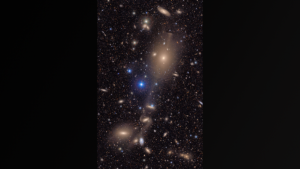WASHINGTON – Like the first brush strokes on a massive canvas, the first images from the Vera C. Rubin Observatory in Chile are a glimpse at the larger picture of our universe to come.
The $571-million National Science Foundation and Department of Energy facility on top of the summit of Cerro Pachon will create the largest astronomical movie yet of the Southern Hemisphere over 10 years, known as the Legacy Survey of Space and Time (LSST).
On Monday, the Vera C. Rubin Observatory revealed its first images of the universe, taken over a period of hours, showcasing the incredible detailed imagery and scale the new facility is capable of. More images and video from these first-look images will be revealed at 11:30 a.m. ET during a live event in Washington. A high-definition stream will be shared live on YouTube here.
Aaron Roodman, of Stanford University SLAC National Accelerator Laboratory, leader of the LSST camera team, said they chose areas of sky that would be “interesting” for these first images, but it almost didn’t matter where they looked.

This image shows a small section of NSF-DOE Vera C. Rubin Observatory’s total view of the Virgo cluster. Bright stars in the Milky Way galaxy shine in the foreground, and many distant galaxies are in the background.
“We’re going to see changing objects,” Roodman said. “We’re going to see moving objects. We’re gonna get a view of thousands and thousands of galaxies and stars in any field we look at. So, in some sense, we could have looked anywhere and gotten fantastic images.”
Who Was Vera Rubin? Dark Matter Astronomer’s Legacy Continues Through New Observatory
The observatory took two decades to complete and was named after the astronomer credited with the first evidence of dark matter. Many in the scientific community still believe Rubin was overlooked for the Nobel Prize.
The brightly colored cosmic landscape below of the Trifid and Lagoon nebulae was taken over seven hours and a combined 678 images. According to the NSF, the clouds of gas and dust are visible due to this image’s layering process.

This image combines 678 separate images taken by NSF-DOE Vera C. Rubin Observatory in just over seven hours of observing time. Combining many images in this way clearly reveals otherwise faint or invisible details, such as the clouds of gas and dust that comprise the Trifid nebula (top right) and the Lagoon nebula, which are several thousand light-years away from Earth.
Rubin’s powerful digital camera was used to capture the Virgo cluster within our home galaxy, the Milky Way. The image below shows two spiral galaxies sparkling in blue, and the ghostly hue of merging galaxies in the upper right.
The Rubin Observatory took more than 1,100 images, showcasing about 10 million galaxies. The galaxy map is just .05% of the 20 billion galaxies that will be captured during the course of the 10-year LSST.

This image shows another small section of NSF-DOE Vera C. Rubin Observatory’s total view of the Virgo cluster. Visible are two prominent spiral galaxies (lower right), three merging galaxies (upper right), several groups of distant galaxies, many stars in the Milky Way galaxy and more.
The speed and power of this new science tool collects petabytes of data – there are more than 1,000 terabytes per petabyte – requiring machine-learning algorithms and data management to process it all.
Deputy Director for Data Management Yusra AlSayyad said the telescope will take an image of the night sky every 30 seconds.
“That’s way too fast for a human to be in the loop and decide where we’re going to observe tonight,” AlSayyad said. You can think of it as a robotic telescope where we are going to use an automated scheduler. To choose the best parts of the sky to observe tonight, in order to achieve the survey goals that we want.”
As the LSST camera collects more data, AlSayyad said it will see rare celestial events, only discovered if AI is always watching.
Original article source: First celestial images from 10-year project photographing the universe released











